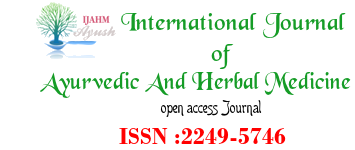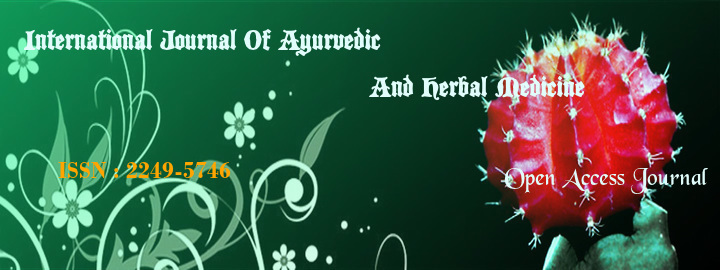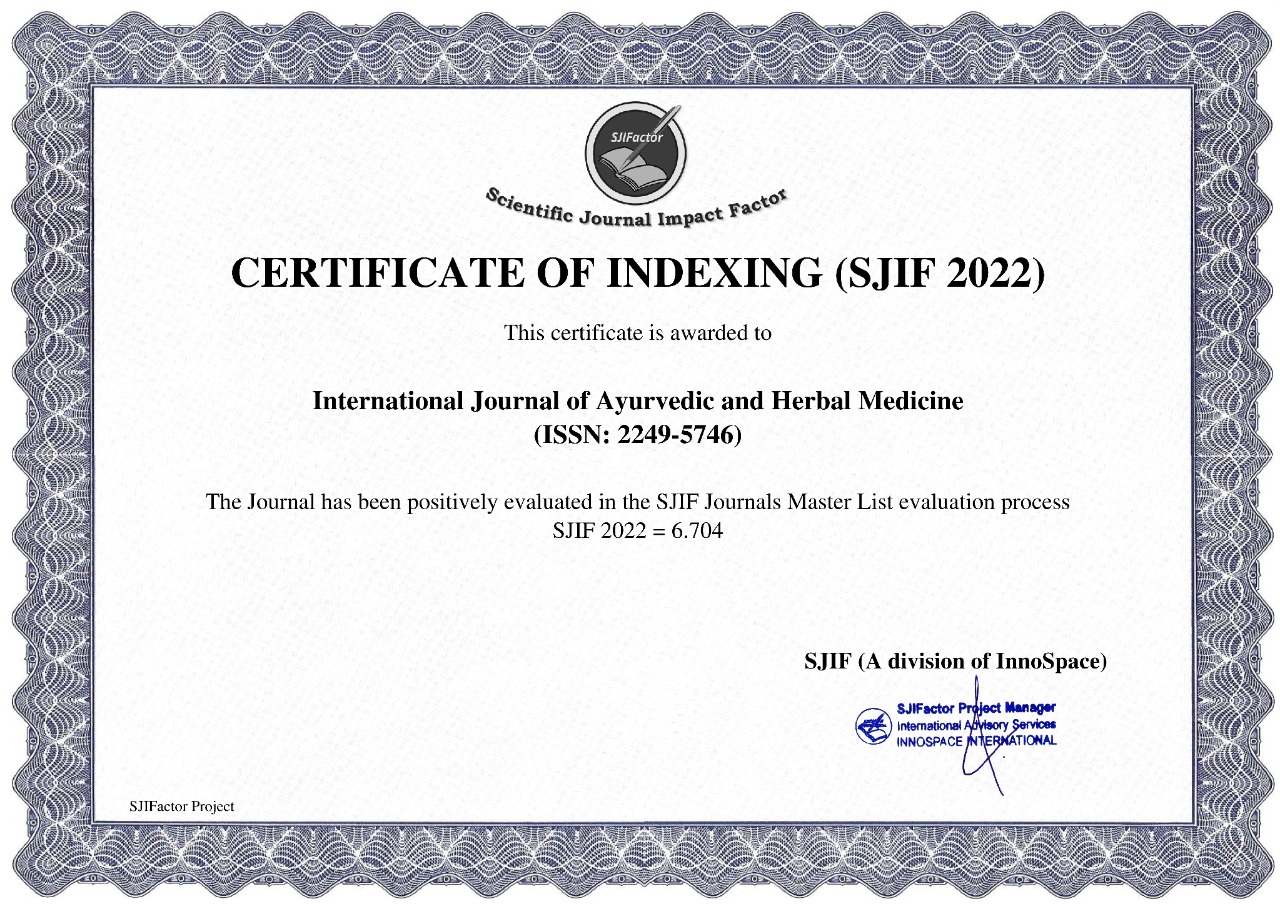


1Sireesha Kalva , 2P. Sailaja Rao , 3Bala Tripura Sundari , 4Prakash V Diwan
1Assistant Professor, Sri Venkateshwara College of Pharmacy, Hyderabad-81.
2Associate professor, Sri Venkateshwara College of Pharmacy, Hyderabad-81.
3 Assistant Professor, Sri Venkateshwara College of Pharmacy, Hyderabad-81.
4Director, Maratha Mandal Research Centre, Belgaum, Karnataka.
*Address for Correspondence: Sireesha.kalva, Assistant Professor,Sri Venkateshwara College of Pharmacy, Madhapur, Hyderabad-81.
Abstract :
The study was designed to evaluate the ethosomal gel of leaf extract of Mangifera indica, its incorporation in to gel formulations. The prepared gels were assessed for their anti-inflammatory activity against carrageenan induced oedema. Different formulations of ethosomes using lecithin, cholesterol and ethanol were prepared using different doses of Mangifera indica herbal leaf extracts. Carbopol 940 was used to prepare ethosomal gel. The entrapment efficiency of ethosomes was 65.1%-96.54% and the average vesicle size was 920nm. Three formulations (different doses) were selected based on entrapment efficiency and drug release. Prepared gels were then evaluated for physicochemical characteristics and drug content. In vivo anti-inflammatory activity studies were carried out using carrageenan-induced rat paw oedema model. Male Wistar rats weighing about 150-180 gms were divided into 5 groups of six rats (n=6) each. Diclofenac sodium was used as a standard drug (MaKami pharmacy). Three gel formulations (100, 200 and 300 mg) were used as test drugs. The pH of the gel formulations was found to be in the range of 5.4-6.2 and viscosities were between 2250- 2399 centipoises. The drug content of gels ranged between 74.67-82.31%. Among the prepared formulations of Mangifera indica FN2 (Formulation 2, 200 mg) was found to possess significant percentage inhibition (54%) when compared to control at 4 hrs. From the study, it can be concluded that ethosomal gel served as an efficient drug delivery system for herbal extract with potential anti-inflammatory property.
Key Words: Ethosomal gel, Mangifera indica, inflammation, physico-chemical properties
REFERENCES
1. Abbas A.B and Lichtman A.H. Chapter 2 Innate immunity. Brain Immunology. Functions and disorders of the immune system. ISBN 3ed. 2009; 978(1): 4160-4688.
2. Mohini P, Parag K, Shailesh K, Meghana L, Sanlhah B, Pravin C. Evaluation of anti-inflammatory activity of herbal gel formultion. J.Nat.prod.Plant Resource; 2011;1(2):25-28.
3. J L Knee et al., Pharmacology; A Nursing process approach, 5th ed., Singapore: Elsevier publications. 2006.
4. Divya Jyothi, Marina K. Formulation and evaluation of an herbal anti-inflammatory gel containing Trigonella Foenum Greacum seed extract.Int J Pharm Sci, 2016; 8(1) :41-44.
5. Parag A. Kulkarni, Shailesh K, Meghana Dhande, Mohini. A Phamse, Pravin D Chowdari. Der Pharm Chemica, 2010; 2(3): 338-342.
6. Mascud Parvez G M. Pharmacological activities of Mango (mangifera indica): A Review. Journal of pharmacognosy and Phytochemistry,2016; 5(3): 01-07.
7. Garrido G, Gonzalez D, Lemus Y, Garica D, Lodeiro C, Quintero G, Delporte c, Numez-Selles AJ and Delgando R. Invivo and In-vitro anti-inflammatory activity of mangifera indica L extract. Pharmacol Res. 2006; 50:143-149.
8. Tarun P, Soniya, roopesh s, Vishal S, Gaurav S, Satyanand T, Chirag P, Anil G. Ethosomes: A recent vesicle of transdermal drug delivery system. Int.J Res Dev Pharm L Sci. 2013; 2(2): 285-292.
9. Vijay Kumar KS, Parthiban S, Senthil GPK, Tamiz TM. Ethosomes-A new trend in vescular approaches for topical drug delivery. Asian J. of Res Pharm Sci and Biotech. 2014; 2(1): 23-30.
10. Nimisha, Nimita. Development and Evaluation of herbal Cosmoceutical for skin care. Int J Pharm Bio Sci. 2013; 4(2): 86-2.
11. Jordan SA, DG Cunningham, RJ Marles. Assessment of herbal medicinal products: Challenges and opportunities to increase the knowledge base for safety assessment. Toxicology and applied Pharmacology. 2010; 243:198-16.
12. Ajila C M, Prasad Rao U J. Protection against hydrogen peroxide induced oxidative damage in rat erythrocytes by Mangifera indica L. peel extract. Food chemical toxicology. 2008; 46(1): 303-309.
13. Rodriguez J, Di-pierro D, Gioia M. Effects of natural extracts from Mangifera indica L and its active compound, mangiferin, on energy state and lipid peroxidation of red blood cells. Biochemical Biophysics. 2006; 1760 (9): 1333-42.
14. Indira S, Priyanka R, Prathima S. Formulation and evaluation of ethosomal topical gels of Etoricoxib. International Journal for Pharmaceutical Research Scholars. 2015; 4(1): 93-103.
15. Sujitha B, Krishnamurthy B, Muthukumaran M. Formulation and evaluation of Piroxicam loaded ethosomal gel for transdermal delivery. International Journal of advanced Pharmaceutical genuine research. 2014; 2(1): 34-45.
16. David S R N, Hui M S, Pin C F, Ci F Y, Rajabalaya R. Formulation and in vitro evaluation of ethosomes as vesicular carrier for enhanced topical delivery of isotretinoin. International Journal of drug delivery. 2013; 5(1):28.
17. Bhana R, Verma A, Jain S. Development and characterization of ethosomes bearing losartan potassium for transdermal drug delivery. International Journal of Pharmacy and Pharmaceutical Sciences. 2013; 5(1): 35-40.
18. Tyagi L K, Kumar S, Mourya S S, Kori M L. Ethosomes novel vesicular carrier for enhanced transdermal drug delivery system. Bulletin of Pharmaceutical research. 2013; 3(1): 6-13.
19. Nimisha, Srivastava K, Kumar Singh A. Formulation and evaluation of Seabuckthorn leaf extract loaded ethosomal gel. Asian Journal of Pharmaceutical and Clinical Research. 2015; 8(5): 316-320.
20. Missal G, Dixit G, Gulkari V. Formulation and evaluation of herbal gel. Indian Journal of natural products and Research. 2012; 3(4): 501-505.
21. Esayed M M, Abdallah O Y, Naggar V F, Khalafallah N M. Lipid vesicles for skin delivery reviewing three decades of research. International journal of Pharmaceutics. 2007; 332: 1-16.
Winter CA, Risley EA, Nuss GW. Carrageenan-induced edema in the hind paw of rat as an assay for anti-inflammatory activity. Proc Soc Exp Biol Med 1962; 111:544-7.
index























